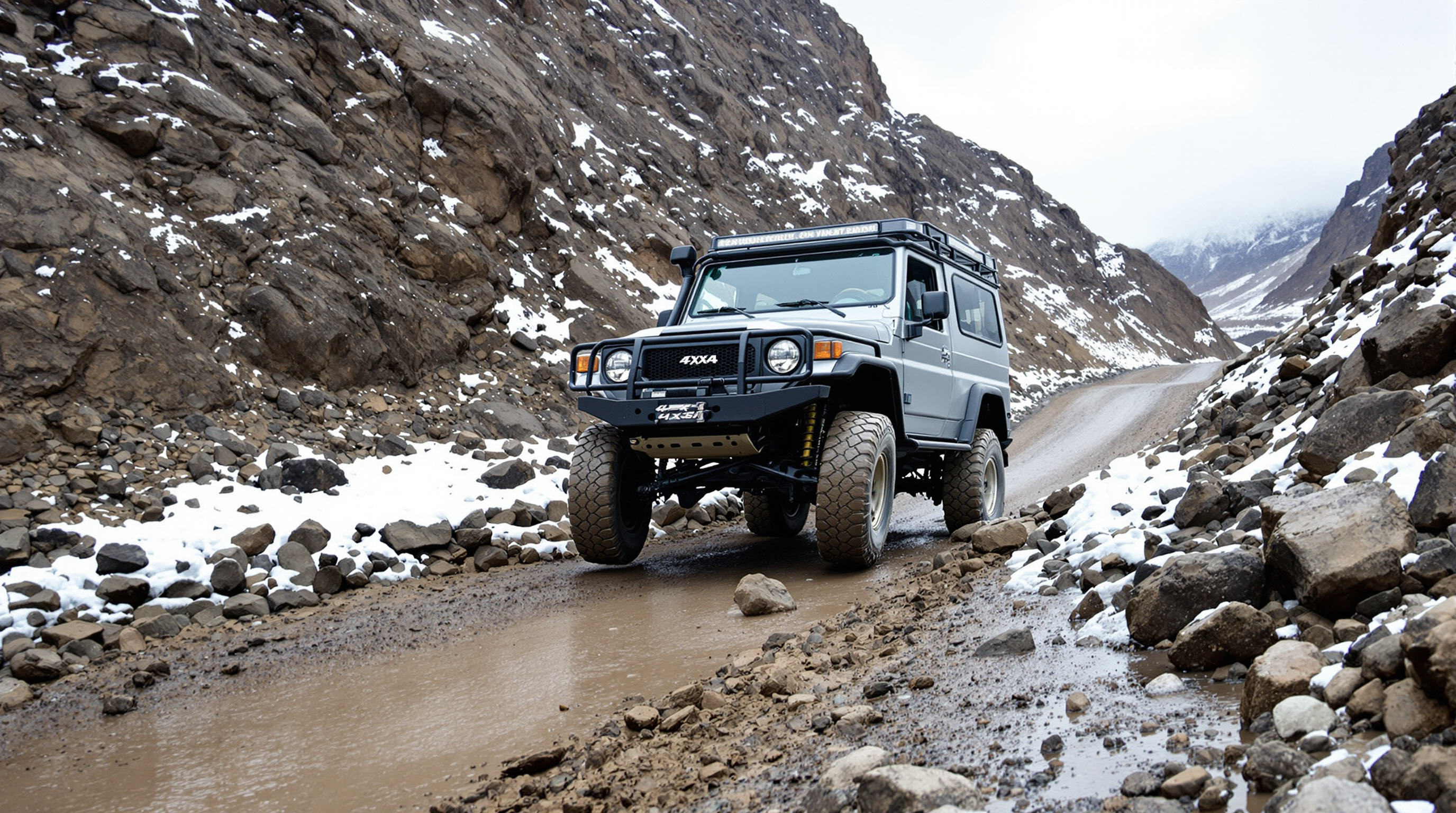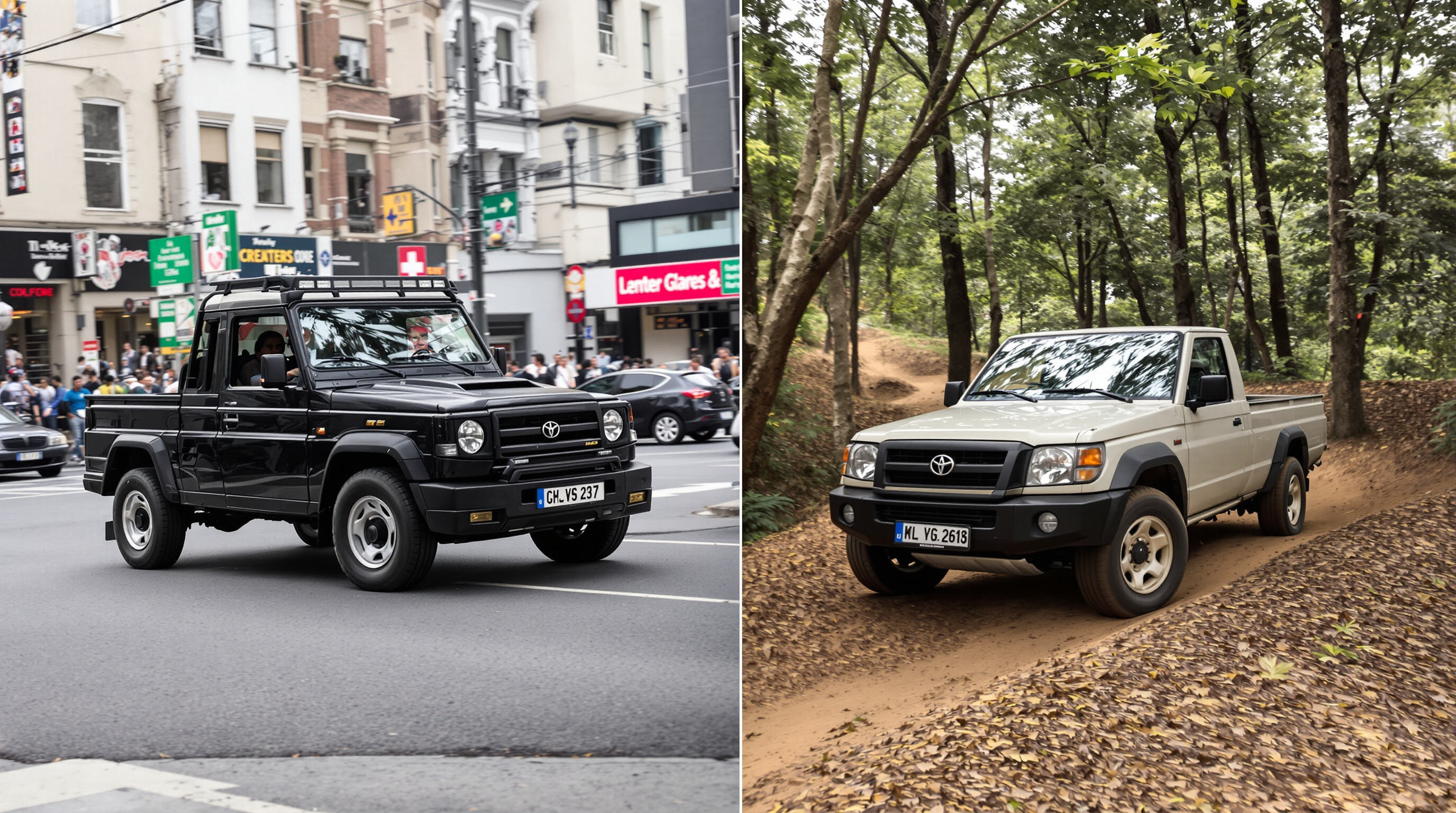Why Small 4x4 Trucks Matter in Remote Delivery
Expanding Access: How Small 4x4 Trucks Enable Remote and Last-Mile Delivery
Rising E-Commerce Demand in Hard-to-Reach Rural and Off-Grid Areas
E-commerce has really taken off in rural areas lately, something we haven't seen before. About 23 percent of all online retail growth these days comes from folks living way out there. The problem? Getting stuff to them remains tough. Traditional delivery trucks often get stuck at trailheads or can't make it through mountain passes when roads are closed seasonally. What's happening here is part of bigger change. People who live outside cities now want their packages delivered just as fast as anyone downtown, even though most places still lack proper infrastructure to support that kind of service.
Bridging the Delivery Gap with Compact, Agile 4x4 Pickup Trucks
The compact 4x4 truck has become something of a workhorse for many logistics operations because it manages to do both off-road driving and city maneuvering pretty well. With those shorter wheelbases, these trucks can actually make their way through forest trails, dirt paths in villages, and even squeeze down narrow downtown streets during the same delivery trip. For companies managing deliveries, this means they get much better options when planning routes since the trucks handle both smooth highways and rough backroads without missing a beat. Transportation experts have noticed that this kind of vehicle is changing how packages get delivered in remote regions and smaller towns where big rigs just don't work or cost too much to operate.
Cost-Effective Utility for Commercial Fleets in Challenging Terrain
Small 4x4 trucks offer strong operational economics for remote delivery:
- Fuel Efficiency: 30% less consumption than full-size alternatives over mixed terrain
- Maintenance: Simplified components reduce downtime (26% fewer maintenance hours vs. specialized off-road vehicles)
- Versatility: Payloads up to 1,450 lbs (TAC 2024) handle bundled deliveries effectively
For fleets serving utilities, medical outreach, or regional e-commerce, this balance of ruggedness and efficiency reduces costs while expanding coverage. One wilderness supply chain cut per-delivery expenses by 44% after switching to compact 4x4s for mountain routes.
Off-Road Capability: Navigating Tough Terrain and Extreme Weather Conditions

Advantages of 4x4 Drivetrains in Mud, Snow, and Unpaved Roads
When it comes to rough terrain, small four-wheel drive trucks generally beat their two-wheel drive counterparts because they spread power evenly to all four wheels. Drivers notice this difference especially during winter months or after heavy rains. The extra traction gives these vehicles around 35-40% better grip in muddy fields or snowy roads, which means less spinning tires on gravel paths or icy patches. What makes this so important? Well, if one set of wheels starts slipping, the other three keep pushing forward. This stability matters a lot for folks working construction sites, delivering supplies in mountain areas, or anyone who needs to stick to tight deadlines despite Mother Nature throwing curveballs.
Comparing Off-Road Performance: Compact vs. Mid-Size 4x4 Trucks
Smaller trucks with wheelbases under 180 inches really shine when space gets tight, which makes them great choices for those winding forest paths and steep mountain roads where bigger vehicles struggle. Mid size pickups do have about 15 to 20 percent more carrying power though, so they work better for folks who need to haul heavier loads regularly. What's interesting these days is that even compact models come equipped with smart terrain response tech. These systems tweak engine response and brake pressure automatically depending on what kind of ground the truck is driving over. The result? Better handling and safer operation without the driver having to constantly make adjustments themselves.
Essential Off-Road Equipment for Reliable Remote Delivery Missions
Three components are vital for dependable operation:
- All-terrain tires with self-cleaning treads for grip in clay-heavy mud
- Underbody skid plates to shield critical components from rock strikes
- Portable recovery gear, including kinetic ropes and folding traction boards
Fleets equipped with these features experience 32% fewer mission delays in extreme conditions, according to field testing.
Case Study: Delivering Medical Supplies to Rural Communities Using Small 4x4 Trucks
When the 2023 monsoon hit Nepal hard, causing massive landslides everywhere, one logistics firm got creative with their approach. They sent out six small 4x4 trucks instead of regular big rigs for keeping vaccines moving through the chaos. These little trucks actually worked wonders because their shorter wheelbase let them squeeze through roads that had been half destroyed by rockslides and mudflows. For three months straight, these vehicles hauled around nearly 18 tons worth of essential medicines and equipment across hundreds of miles where most roads looked like something from a war zone. Pretty impressive considering they managed to get stuff delivered on time almost all the time - about 98 percent of shipments made it when expected despite everything going on.
Maneuverability and Fuel Efficiency: Operational Advantages in Diverse Environments

Urban to Wilderness: The Agility of Compact and Mid-Size Pickup Trucks
The smaller 4x4 trucks have a real advantage when it comes to getting around places that bigger rigs just can't handle. These compact beasts typically measure about 18.3 feet long according to Automotive Research Group data from last year, which makes them much easier to maneuver through tight urban spaces or rough backcountry trails. Logistics companies reported something interesting too - a recent 2023 study showed that when they switched to these smaller trucks, their drivers made 29% fewer mistakes on routes that mix pavement with dirt roads. Why? Well, these trucks simply turn better because of their tighter radius and sit lower to the ground, giving them more stability overall.
Fuel Economy: Small 4x4 Trucks vs. Full-Size Alternatives
Fuel efficiency is crucial for remote logistics. Modern small 4x4 trucks achieve 21-24 MPG combined (EPA 2023), outperforming full-size trucks (14-17 MPG) by 35-41%. For fleets logging 25,000 miles annually, this translates to $3,200-$4,700 in yearly fuel savings. Electric-assist models enhance these gains, with some prototypes showing 50% lower energy use in stop-and-go delivery cycles.
Hybrid Powertrains in Small 4x4 Trucks: Efficiency Without Sacrificing Performance
Hybrid systems resolve the torque-efficiency tradeoff in tough terrain:
- Regenerative braking recovers 15-20% of energy in mountainous areas (Powertrain Innovation Report 2024)
- Electric motor assist enables 6,500-lb towing with 30% lower fuel consumption
- Improved cold-start reliability reduces winter downtime by up to 40%
Their modular design allows fleets to adjust battery capacity based on route demands, blending electric efficiency with mechanical simplicity essential for remote operations.
Durability and Practical Design: Built for Harsh Conditions and Field Reliability
Reliability and Mechanical Simplicity in Extreme Operating Environments
Small four wheel drive trucks are built to handle some seriously tough environments, whether it's freezing arctic temperatures or blistering desert heat. These trucks have fewer electronics and simpler drivetrain designs which means they break down less often. According to the latest Off Road Vehicle Durability Study from 2024, models with these basic systems actually had about 30 percent fewer problems compared to their high tech counterparts when put through rough conditions. What makes them so dependable? Look at features like reinforced transmissions that can take a beating, special alloys that resist rust even in salty coastal areas, and bearings that stay sealed against dirt and moisture. Standard cars just aren't built to last in places where these rugged trucks shine.
Functional Design Features That Enhance Field Utility
Smart design boosts real-world usability. Flatbed tie-down anchors, elevated air intakes, and underbody skid plates help operators traverse flooded roads or rocky trails without cargo compromise. Waterproof electrical systems (IP67-rated or higher) resist moisture damage, while modular interiors allow quick reconfiguration for medical supplies, tools, or perishables.
The Lightweight Yet Heavy-Duty Paradox in Small 4x4 Truck Engineering
Innovative materials enable a critical balance: high-strength boron steel frames and aluminum alloy bodies reduce weight by 15-20% without sacrificing strength. This allows compact 4x4s to maintain a 1,500-2,000 lb payload capacity while achieving 22-28 MPG-key for cost-sensitive operations in fuel-scarce regions.
Payload, Towing, and Real-World Utility in Remote Logistics Operations
Payload Capacity in Modern Small 4x4 Trucks: Meeting Field Demands
Modern small 4x4 trucks support payloads of 1,000-2,000 lbs-sufficient for tools, spare parts, or emergency supplies. This enables rural businesses and service providers to transport essentials without relying on full-sized rigs. When operated within limits, their mechanical simplicity ensures long-term reliability.
Towing Performance in Hybrid and Electric Compact 4x4 Models
Electric motors deliver instant torque, enhancing towing in difficult terrain. Hybrid models show 40% better hill-climbing performance than gas-powered equivalents, while regenerative braking improves control on steep descents with trailers. Despite compact dimensions, these trucks can tow over 6,000 lbs while maintaining agility in tight spaces.
Real-World Applications: Adventure, Aid, and Off-Grid Supply Chains
These vehicles sustain remote communities by enabling:
- Medical supply deliveries to mountain clinics
- Transport of solar and wind equipment for off-grid energy projects
- Seasonal resupply to Arctic research stations
A recent study highlights their growing role in rugged terrain logistics and disaster relief, with deployment increasing 17% annually.
FAQ
Why are small 4x4 trucks suitable for rural e-commerce delivery?
Small 4x4 trucks are ideal for rural e-commerce delivery due to their ability to navigate challenging terrains such as muddy fields and snowy roads, and their cost-effective operation compared to larger trucks. Their compact size also allows them to maneuver through narrow streets and off-road paths.
What are the economic benefits of using small 4x4 trucks in logistics?
These trucks provide significant economic benefits, including fuel efficiency that results in lower consumption and maintenance costs due to simpler components. Additionally, they offer versatility in payload capacities, which is effective for bundled deliveries.
How do small 4x4 trucks perform in extreme weather conditions?
Small 4x4 trucks perform well in extreme weather conditions due to their 4-wheel drivetrains that provide better traction and grip on muddy and snowy roads. Essential off-road equipment such as all-terrain tires and skid plates further enhance their capability to handle tough terrain.

